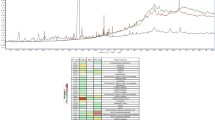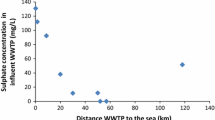Abstract
The contribution of the major technologically important microbial groups (ammonium- and nitrite-oxidizing, phosphate-accumulating, foam-inducing, and anammox bacteria, as well as planctomycetes and methanogenic archaea) was characterized for the aeration tanks of the Moscow wastewater treatment facilities. FISH investigation revealed that aerobic sludge were eubacterial communities; the metabolically active archaea contributed insignificantly. Stage II nitrifying microorganisms and planctomycetes were significant constituents of the bacterial component of activated sludges, with Nitrobacter spp. being the dominant nitrifiers. No metabolically active anammox bacteria were revealed in the sludge from aeration tanks. The sludge from the aeration tanks using different wastewater treatment technologies were found to have differing characteristics. Abundance of the nitrifying and phosphate-accumulating bacteria in the sludge generally correlated with microbial activity in microcosms and with efficiency of nitrogen and phosphorus removal from wastewater. The highest microbial numbers and activity were found in the sludge of the tanks operating according to the technologies developed in the universities of Hannover and Cape Town. The activated sludge from the Novokur’yanovo facilities, where abundant growth of filamentous bacteria resulted in foam formation, exhibited the lowest activity. The group of foaming bacteria included Gordonia spp. and Acinetobacter spp utilizing petroleum and motor oils, Sphaerotilus spp. utilizing unsaturated fatty acids, and Candidatus ‘Microthrix parvicella’. Thus, the data on abundance and composition of metabolically active microorganisms obtained by FISH may be used for the technological control of wastewater treatment.
Similar content being viewed by others
References
Nozhevnikova, A.N., Biological treatment of organic wastes, in Ekologiya mikroorganizmov (Microbial Ecology), Netrusov, A.N, Ed., Moscow: Akademiya, 2004, pp. 175–195.
Nielsen, P.H., Nguyen, H.T.T., McIlroy, S.J., Mielczarek, A.T., and Seviour, R., Identification of polyphosphate-accumulating and glycogen-accumulating organisms by FISH, in FISH Handbook for Biological Wastewater Treatment. Identification and Quantification of microorganisms in Activated Sludge Biofilms by FISH, Nielsen, P.H., Daims, H., and Lemmer, H., Eds., London: IWA, 2009, pp. 25–31.
Sevior, R. and Nielsen, P.H., Microbial communities in activated sludge plants, in Microbial Ecology of Activated Sludge, Sevior, R. and Nielsen, P.H., Eds., London: IWA, 2010, pp. 95–126.
Bjornsson, L., Hugenholtz, P., Tyson, G.W., and Blackall, L.L., Filamentous Chloroflexi (green non-sulfur bacteria) are abundant in wastewater treatment processes with biological nutrient removal, Microbiology (UK), 2002, vol. 148, pp. 2309–2318.
Metodika tekhnologicheskogo kontrolya raboty ochistnykh sooruzhenii gorodskoi kanalizatsii (Methods for technological Control of the Operation of Municipal Sewage Treatment Plants), Moscow: Stroiizdat, 1977.
Kozlov, M.N., Danilovich, D.A., Sklyar, V.I., Moizhes, O.V., Dorofeev, A.G., and Grachev, V.A., Monitoring of the biochemical activity of the sludge of the Moscow purification installations, Vodosnab. San. Tekhn., 2006, no. 11, pp. 49–55.
Janssen, P.M.J., Meinema, K., and van der Roest, H.F., Biological Phosphorus Removal: Manual for Design and Operation, London: IWA, 2002.
Pankratov, T.A., Belova, S.E., and Dedysh, S.N., Evaluation of the phylogenetic diversity of prokaryotic microorganisms in Sphagnum peat bogs by means of fluorescence in situ hybridization (FISH), Microbiology (Moscow), 2005, vol. 74, no. 6, pp. 722–728.
Amann, R.I., Binder, B.J., Olsen, R.J., Chisholm, S.W., Devereux, R., and Stahl, D.A., Combination of 16S rRNA-targeted oligonucleotide probes with flow cytometry for analyzing mixed microbial populations, Appl. Environ. Microbiol., 1990, vol. 56, pp. 1919–1925.
Amann, R.I., Krumholz, L., and Stahl, D.A., Fluorescent-oligonucleotide probing of whole cells for determinative, phylogenetic, and environmental studies in microbiology, J. Bacteriol., 1990, vol. 172, pp. 762–770.
Zarda, B., Hahn, D., Chatziotas, A., Schonhuber, W., Neef, A., Amann, R.I., and Zeyer, J., Analysis of bacterial community structure in bulk soil by in situ hybridization, Arch. Microbiol., 1997, vol. 168, pp. 185–192.
Stahl, D.A. and Amann, R., Development and application of nucleic acid probes, in Nucleic Acid Techniques in Bacterial Systematic, Stackebrandt, E. and Goodfellow, M., Eds., New York: Wiley, 1991, pp. 205–248.
Daims, H., Brühl, A., Amann, R., Schleifer, K.-H., and Wagner, M., The domain-specific probe EUB338 is insufficient for the detection of all bacteria: Development and evaluation of a more comprehensive probe set, Syst. Appl. Microbiol., 1999, vol. 22, pp. 434–444.
Neef, A., Amann, R., Schlesner, H., and Schleifer, K.H., Monitoring a widespread bacterial group: in situ detection of planctomycetes with 16S rRNA-targeted probes, Microbiology (UK), 1998, vol. 144, pp. 3257–3266.
Wagner, M., Rath, G., Amann, R., Koops, H.-P., and Schleifer, K.-H., In situ identification of ammoniaoxidizing bacteria, Syst. Appl. Microbiol., 1995, vol. 18, pp. 251–264.
Mobarry, B.K., Wagner, M., Urbain, V., Rittmann, B.E., and Stahl, D.A., Phylogenetic probes for analyzing abundance and spatial organization of nitrifying bacteria, Appl. Environ. Microbiol., 1996, vol. 62, pp. 2156–2162.
Wagner, M., Rath, G., Koops, H.P., Flood, J., and Amann, R., In situ analysis of nitrifying bacteria in sewage treatment plants, Wat. Sci. Technol., 1996, vol. 34, pp. 237–244.
Daims, H., Nielsen, J.L., Nielsen, P.H., Schleifer, K.H., and Wagner, M., In situ characterization of Nitrospira-like nitrite-oxidizing bacteria active in wastewater treatment plants, Appl. Environ. Microbiol., 2001, vol. 67, pp. 5273–5284.
Crocetti, G.R., Hugenholtz, P., Bond, P.L., Schuler, A., Keller, J., Jenkins, D., and Blackall, L.L., Identification of polyphosphate-accumulating organisms and design of 16S rRNA-directed probes for their detection and quantification, Appl. Environ. Microbiol., 2000, vol. 66, pp. 1175–1182.
Wagner, M., Erhart, R., Manz, W., Amann, R., Lemmer, H., Wedi, D., and Schleifer, K.-H., Development of an rRNA-targeted oligonucleotide probe specific for the genus Acinetobacter and its application for in situ monitoring in activated sludge, Appl. Environ. Microbiol., 1994, vol. 60, pp. 792–800.
De los Reyes, F.L., Ritter, W., and Raskin, L., Groupspecific small-subunit rRNA hybridization probes to characterize filamentous foaming in activated sludge systems, Appl. Environ. Microbiol., 1997, vol. 63, pp. 1107–1117.
Erhart, R., Bradford, D., Seviour, R.J., Amann, R., and Blackall, L.L., Development and use of fluorescent in situ hybridization probes for the detection and identification of “Microthrix parvicella” in activated sludge, Syst. Appl. Microbiol., 1997, vol. 20, pp. 310–318.
Schmid, M., Walsh, K., Webb, R., Rijpstra, W.I., van de Pas-Schoonen, K., Verbruggen, M.J., Hill, T., Moffett, B., Fuerst, J., Schouten, S., Damsté, J.S., Harris, J., Shaw, P., Jetten, M., and Strous, M., Candidatus “Scalindua brodae,” sp. nov., Candidatus “Scalindua wagneri,” sp. nov., two new species of anaerobic ammonium oxidizing bacteria, Syst. Appl. Microbiol., 2003, vol. 26, pp. 529–538.
Jurgens, G., Glöckner, F., Amann, R., Saano, A., Montonen, L., Likolammi, M., and Munster, U., Identification of novel archaea in bacterioplankton of a boreal forest lake by phylogenetic analysis and fluorescent in situ hybridization, FEMS Microbiol. Ecol., 2000, vol. 34, pp. 45–56.
Sorensen, A., Torsvik, V., Torsvik, T., Poulsen, L., and Ahring, B., Whole-cell hybridization of Methanosarcina cells with two new oligonucleotide probes, Appl. Environ. Microbiol., 1997, vol. 63, pp. 3043–3050.
Bassin, J.P., Pronk, M., Muyzer, G., Kleerebezem, R., Dezotti, M., and van Loosdrecht, M.C.M., Effect of elevated salt concentrations on the aerobic granular sludge process: linking microbial activity with microbial community structure, Appl. Environ. Microbiol., 2011, vol. 77, pp. 7942.
Nielsen, J.L. and Nielsen, P.H., Quantification of functional groups in activated sludge by microautoradiography, Wat. Sci. Technol., 2002, vol. 46, pp. 389–395.
Bouvier, T. and del Giorgio, P.A., Factors influencing the detection of bacterial cells using fluorescence in situ hybridization (FISH): a quantitative review of published reports, FEMS Microbiol. Ecol., 2003, vol. 44, pp. 3–15.
Kondrat’eva, E.N., Avtotrofnye prokarioty (Autotrophic Prokaryotes), Ivanovskii, R.N., Ed., Moscow: Mos. Gos. Univ., 1996.
Daims, H., Maixner, F., and Schmid, M.C., The nitrifying microbes: Ammonia oxidizers, nitrite oxidizers, and anaerobic ammonium oxidizers, in FISH Handbook for Biological Wastewater Treatment. Identification and Quantification of Microorganisms in Activated Sludge Biofilms by FISH, Nielsen, P.H., Daims, H., and Lemmer, H., Eds., London: IWA, 2009, pp. 9–17.
Chiellini, C., Munz, G., Petroni, G., Lubello, C., Mori, G., Verni, F., and Vannini, C., Characterization and comparison of bacterial communities selected in conventional activated sludge and membrane bioreactor pilot plants: a focus on Nitrospira and Planctomycetes bacterial phyla, Curr. Microbiol., 2013, vol. 67, pp. 77–90.
Seviour, R.J., Mino, T., and Onuki, M., The microbiology of biological phosphorus removal in activated sludge systems, FEMS Microbiol. Rev., 2003, vol. 27, pp. 99–127.
Hesselmann, R.P.X., Werlen, C., Hahn, D., van der Meer, J.R., and Zehnder, A.J.B., Enrichment, phylogenetic analysis and detection of a bacterium that performs enhanced biological phosphate removal in activated sludge, Syst. Appl. Microbiol., 1999, vol. 22, pp. 454–465.
Author information
Authors and Affiliations
Corresponding author
Additional information
Original Russian Text © A.Yu. Kallistova, N.V. Pimenov, M.N. Kozlov, Yu.A. Nikolaev, A.G. Dorofeev, V.G. Aseeva, V.A. Grachev, E.V. Men’ko, Yu.Yu. Berestovskaya, A.N. Nozhevnikova, M.V. Kevbrina, 2014, published in Mikrobiologiya, 2014, Vol. 83, No. 5, pp. 615–625.
Rights and permissions
About this article
Cite this article
Kallistova, A.Y., Pimenov, N.V., Kozlov, M.N. et al. Microbial composition of the activated sludge of Moscow wastewater treatment plants. Microbiology 83, 699–708 (2014). https://doi.org/10.1134/S0026261714050154
Received:
Published:
Issue Date:
DOI: https://doi.org/10.1134/S0026261714050154




